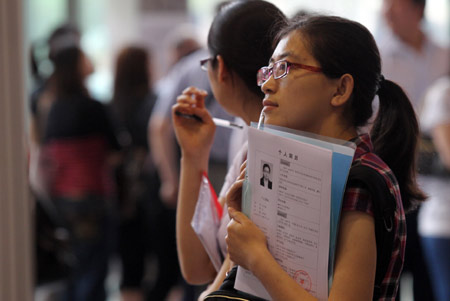Economy
Hiring plans hit 6-year high
By Wang Xiaotian (China Daily)
Updated: 2010-06-09 09:07
 |
Large Medium Small |
|
 |
|
Applicants checking out employment opportunities at a recent job fair in Beijing. [China Daily] |
Manpower survey says employers to recruit more employees in Q3
BEIJING - Hiring plans by mainland employers surged to a six-year high on growing optimism about the nation's economic expansion, even as analysts warned of more labor shortages in first-tier cities.
More than 30 percent of mainland employers plan to increase their workforce in the third quarter, making China one of the most promising job markets in the world after India and Brazil, according to a report released by employment service provider Manpower Inc on Tuesday.
The figure was only around 10 percent for the same period of last year.
The Manpower survey interviewed over 3,607 companies in the mainland. Only 4 percent of employers said they plan to reduce their headcount during the period.
Employers in the services sector seemed more likely to add jobs compared with other sectors like the wholesale & retail trade, finance, insurance & real estate, manufacturing, and transportation & utilities, largely due to the demand triggered by the Shanghai World Expo.
"The remarkable improvement could be due to more orders and growing demand from export-oriented and labor-intensive companies," said Yuan Jianhua, managing director of Manpower China. Demand for labor has also increased as more and more foreign companies are expanding into second- and third-tier cities.
Liu Jianhui, an analyst with the State Council's Development and Research Center, said the current scenario bucks the cooling down trend in jobs during the third quarter, after a peak in the second quarter.
Yuan said the economy seems to be recovering quickly, and many companies are in urgent need of employees to cope with the increased demand. That in turn, may also aggravate the labor shortage in regions like the Yangtze River Delta and the Pearl River Delta.
According to an earlier survey by the Ministry of Human Resources and Social Security, workforce demand rose by 15 percent after the Spring Festival holiday this year compared with the same period last year.
A serious labor shortage was reported in the Pearl River Delta at the beginning of the year, where it is anticipated that factories may need at least 2 million more employees to meet demand.
Employees, on the other hand, are frustrated by the poor pay and high living costs in big cities and would rather work in emerging cities near their hometowns, said analysts.
Liu said the recent spate of suicides at electronics manufacturer Foxconn and the strike at Honda units were extreme cases reflecting the tight labor situation.
The labor shortage problem will also continue in the long term as hiring demand will surge continuously, said 51job, a well-known online employment service company in China.
According to one of its polls in 63 major cities, the ratio of vacant positions to applicant numbers reached 0.98 in April this year from 0.85 in 2009.
"The labor shortage, together with the contradiction that many businesses cannot find employees when many are jobless, would become a permanent phenomenon in our society," said Zhang Juwei, professor and director of the labor and social security research center at the Chinese Academy of Social Sciences.
He said the increased hiring enthusiasm in the third and fourth quarter of this year would widen the gap, considering that the nation's economy is recovering rapidly and the new workforce pool is decreasing.



